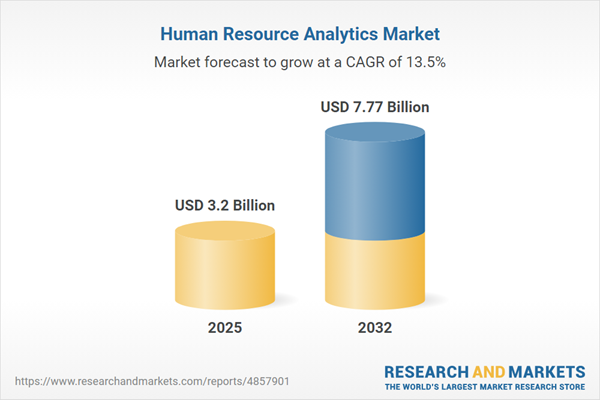Speak directly to the analyst to clarify any post sales queries you may have.
The Human Resource Analytics Market is redefining how organizations approach talent management and digital efficiency. By transforming HR into a strategic partner, analytics solutions are enabling senior decision-makers to leverage workforce data for improved business outcomes and operational agility.
Market Snapshot: Human Resource Analytics Market Size and Growth
The Human Resource Analytics Market is experiencing sustained expansion, with size rising from USD 2.83 billion in 2024 to USD 3.20 billion in 2025. This growth trajectory is backed by a 13.45% compound annual growth rate and is anticipated to reach USD 7.77 billion by 2032. Organizations are driving this acceleration by adopting analytics platforms to enhance talent acquisition, retention, and productivity. Evolving operational environments highlight the need for robust workforce data to inform critical HR strategies while supporting more efficient processes and proactive decision-making in dynamic business landscapes.
Scope & Segmentation of the Human Resource Analytics Market
This report delivers a thorough perspective on the human resource analytics ecosystem, presenting actionable market segmentation relevant to HR and IT leaders driving modernization efforts. The scope addresses key challenges and adoption incentives in component choices, deployment preferences, organizational needs, sector-specific priorities, and global expansion requirements.
- Component: Services include consulting, integration, deployment, training, and support. Solutions focus on HR management, predictive analytics, reporting and visualization, talent management, and workforce optimization.
- Deployment Model: Options span hybrid, private, and public cloud setup as well as on-premise solutions, supporting unique compliance and scalability demands for diverse organizations.
- Organization Size: Solutions are tailored for large enterprises and small to medium-sized businesses, addressing unique analytics needs and degrees of data integration.
- Industry Vertical: Platforms support key sectors, including BFSI, government and public sector, healthcare and life sciences, IT and telecom, manufacturing, retail, and e-commerce. Providers adapt offerings to sector regulations and workforce trends.
- Regional Coverage: The geographic scope comprises the Americas (such as the United States, Canada, Mexico, and Brazil), Europe (including the United Kingdom, Germany, and France), the Middle East (like UAE and Saudi Arabia), Africa (including South Africa and Nigeria), and Asia-Pacific markets (such as China, India, Japan, and Australia), providing deep insight into region-specific adoption drivers.
- Leading Providers: Benchmarked organizations include SAP SE, Oracle Corporation, Workday Inc., Automatic Data Processing Inc., International Business Machines Corporation, Infor Inc., Ceridian HCM Inc., Ultimate Kronos Group Inc., Cornerstone OnDemand Inc., and Visier Inc. Their diverse portfolios enhance enterprise capabilities in HR analytics.
Key Takeaways for Senior Decision-Makers
- Human resource analytics transforms HR into a proactive, data-driven function, empowering organizations to anticipate workforce trends and align talent management with strategic priorities.
- Unified analytics across hiring, engagement, and performance management creates comprehensive dashboards, increasing visibility and enhancing response times for leadership teams.
- Advanced technologies—including AI, machine learning, and cloud computing—are streamlining predictive insights for employee retention, targeted learning, and productivity optimization.
- User-oriented visualization tools foster analytics adoption among HR and business leaders, promoting a culture of data-driven decision-making and elevating workforce data literacy.
- Flexible analytics offerings safeguard compliance, manage sensitive workforce data securely, and deliver actionable insights specific to industry regulations and business needs.
- Vendor collaboration through strategic partnerships and acquisitions accelerates solution innovation and enhances analytics deployment across enterprises.
Impact of United States Tariff Policies on Infrastructure
With changes in United States tariff policies increasing hardware procurement costs, organizations are reevaluating infrastructure investments. This shift is driving increased interest in cloud-based deployments, automation solutions, and localized HR analytics approaches to better manage budgets and address future scalability. These market responses emphasize the importance of strategic sourcing, the adoption of hybrid cloud models, and the careful balancing of performance, security, and cost efficiency when planning analytics infrastructure upgrades.
Methodology & Data Sources
This market outlook is grounded in primary interviews with C-suite executives, HR leaders, and technology specialists across multiple regions, combined with in-depth secondary research sourced from leading industry reports and company records. Triangulation and thematic analysis ensure findings are accurate and relevant for strategic decisions.
Why This Report Matters for Strategic Planning
- Gain authoritative insights into technology trends, shifting regulatory factors, and evolving regional requirements in the human resource analytics market.
- Clarify critical segmentation variables and regional distinctions to optimize technology investments and implementation strategies.
- Benchmark top solution providers and their partnerships, supporting ongoing transformation and competitive positioning in HR analytics.
Conclusion
Human resource analytics serves as a foundation for organizational agility and workforce excellence. This research enables leaders to build strategies that reinforce resilience and position HR initiatives squarely within overarching business objectives.
Additional Product Information:
- Purchase of this report includes 1 year online access with quarterly updates.
- This report can be updated on request. Please contact our Customer Experience team using the Ask a Question widget on our website.
Table of Contents
3. Executive Summary
4. Market Overview
7. Cumulative Impact of Artificial Intelligence 2025
List of Figures
Samples

LOADING...
Companies Mentioned
The key companies profiled in this Human Resource Analytics market report include:- SAP SE
- Oracle Corporation
- Workday, Inc.
- Automatic Data Processing, Inc.
- International Business Machines Corporation
- Infor, Inc.
- Ceridian HCM, Inc.
- Ultimate Kronos Group, Inc.
- Cornerstone OnDemand, Inc.
- Visier, Inc.
Table Information
| Report Attribute | Details |
|---|---|
| No. of Pages | 186 |
| Published | October 2025 |
| Forecast Period | 2025 - 2032 |
| Estimated Market Value ( USD | $ 3.2 Billion |
| Forecasted Market Value ( USD | $ 7.77 Billion |
| Compound Annual Growth Rate | 13.4% |
| Regions Covered | Global |
| No. of Companies Mentioned | 11 |









